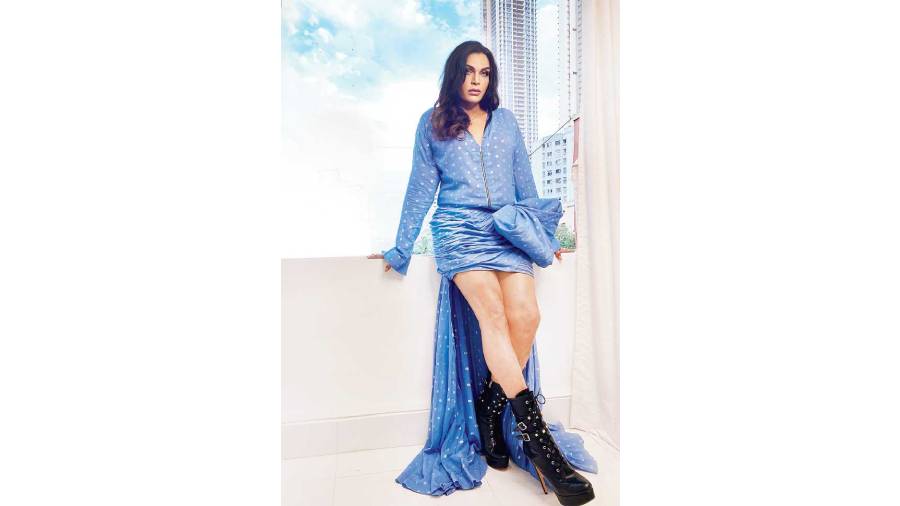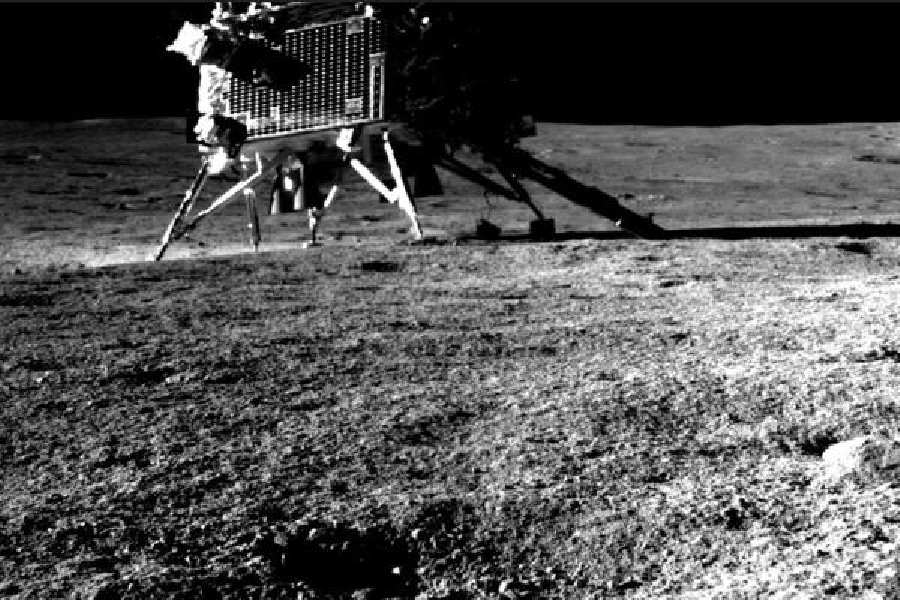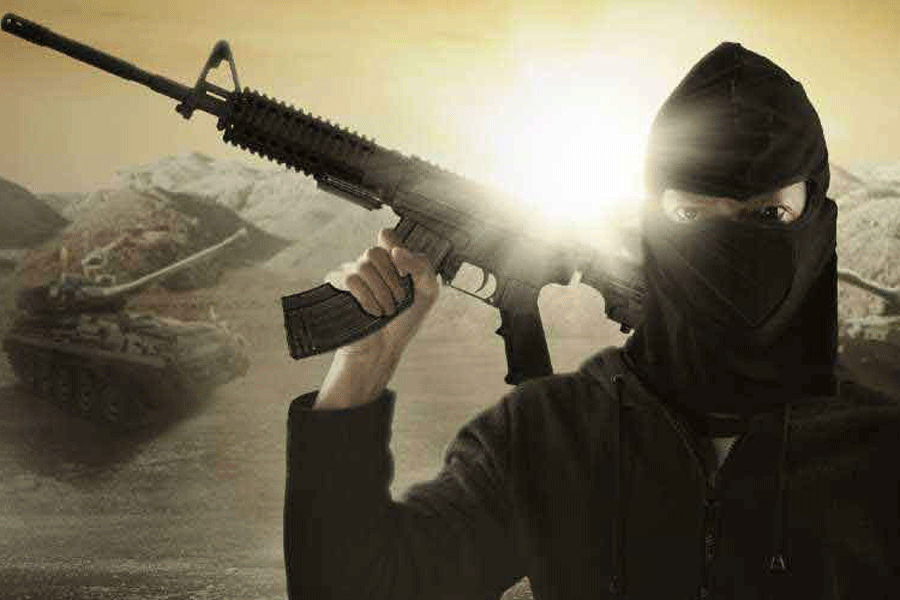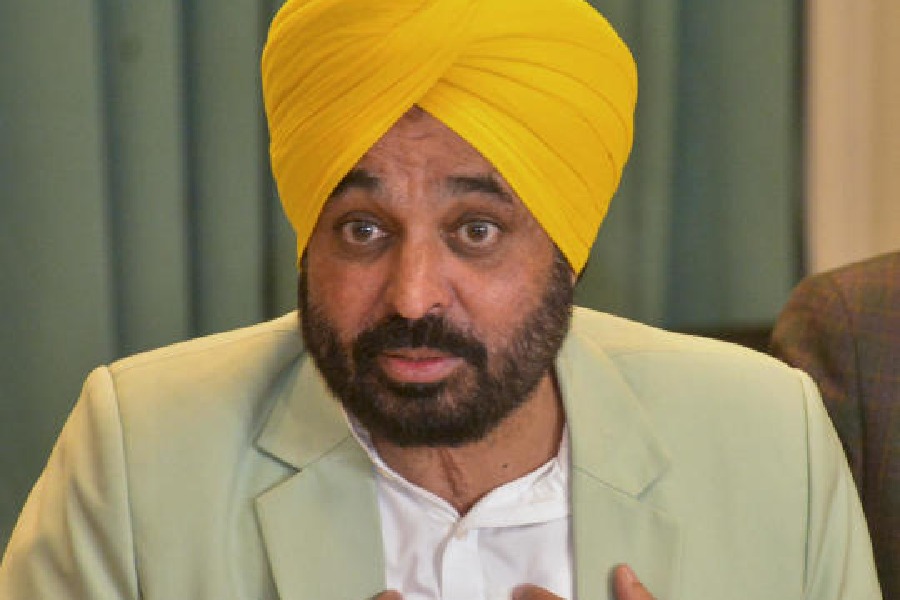All through school and college, while the boys outside tormented me because I was different, the internal pain was far worse. I felt suffocated living a reality that I knew wasn’t mine, yet one that I had to stage everyday because of societal expectations and norms. It was only in my early 20s at NIFT where I found the courage to accept my truth; I truly bloomed... I am a Transwoman,” wrote Saisha Shinde on her Instagram in January. Known to the fashion world and Bollywood as Swapnil Shinde for over a decade and a half, the year 2021 was sort of a rebirth for the fashion designer as she chose to come out as a transwoman and rename herself. As the Transgender Awareness Week — observed every year from November 13 to 19 to raise awareness on transphobic violence, issues of identity and transition faced by people identifying as transgender or gender non-conforming — comes to an end, Shinde engaged in a heart-to-heart conversation with t2, sharing her experiences of this new innings in life.
It has been a year of many firsts for you. Can you describe in a word how it feels?
Overwhelming!
Many people feel hesitant to take this step thinking of social stigma. What inspired you to come out?
Firstly, I am independent and have a secure place in terms of my professional life. I knew that I did not have to worry about societal pressure. But at the same time when I think if I would have been able to do this 10 or 12 years ago when I was starting my career, the answer would probably be no. So, for me, my professional stability made it a lot easier. As far as my professional life is concerned, be it the actresses or the stylists or my clients, all of them were great support. I knew my career is not going to get affected whatsoever. Secondly, that was also the downside for me. Because I am a public figure, I knew that my personal life will get magnified. That was one of the decisions I had to make.
If you were not a part of the limelight, would you think twice?
I don’t know what would happen. But I can say that because I come from the fashion and film industry, I know people are a lot more open, accepting and understanding here. About 10 or 15 years ago, it probably would have been a lot more challenging and also we have to understand that we did not have social media and the Internet then. For us to get the reach, adulation, support and positive boost from the followers is a lot easier now. That I have been an established designer has been my benefit, I feel.
You embrace your past identity as a gay man and your present as a transwoman with an equally strong sense of acceptance. What is the source behind your strength ?
This is probably where my upbringing comes in. My parents have always taught me to be fearless and asked me to achieve my dreams without any fear as long as I have an expertise in it. That has been my backbone. I drove into experiences without fear and that attitude came in with my sexuality as well, whether it was accepting that I was gay or eventually accepting that I am trans. Yes, it took some time but the day I accepted it for myself, I accepted it openly because this is not something that you have to be shy of. Until and unless I was sure, I didn’t come out. This is something you have to accept as a part of your life and that notion will change only when you are slightly fearless in life.
How did you cope with your phase of gender dysphoria?
It has just been a year for me transitioning and it is still very fresh and there are still days that are very heavy on gender dysphoria for me. Something as simple as dressed up head to toe in a woman’s attire with full make-up and hair done and still someone would call me sir. There’s nothing wrong in that. He is being very respectful, he just doesn’t know the pronouns and the terms but obviously those are the days that dysphoria hits me heavily and the way I combat it is therapy and my amazing bunch of family and friends (help me do that). And of course, talking to other fellow trans women who talk about their experiences, I feel I am not alone and can deal with it.
The LGBTQ+ community’s biggest struggle is in finding acceptance. What role did your family and friends’ support play in this journey ?
I come from a Maharashtrian conservative background but we are not regressive. Our values are slightly conservative but not regressive. When I got into fashion, my parents got introduced to this world which was so glamorous and real and were sort of growing an idea of acceptance. I am talking about late 90s and early 2000s. But when I came out as a gay man and then as a transwoman, there was much confusion. There is very little information out there for a generation that has gone by... television and the media that that generation follows are extremely regressive still. So, until and unless the mass media normalises this or have characters in their show and movies that are humans and not caricatures, acceptance is going to take time.
For my family, it was much easier because they know that I am successful and that I am not going to be in trouble and I am still going to remain successful and have a good life. Eventually all parents want their kids to be successful and happy. The one thing I have been stressing on since I came out is for more people to come out, especially those who are privileged, because the ones who are privileged are going to least get affected by it. And having those visuals of privileged people from more walks of life, the masses can look up to these people and think that their kids can have a future too no matter what they choose. And friends are always going to be there for you. They have been with me when I felt confused and was a great support.
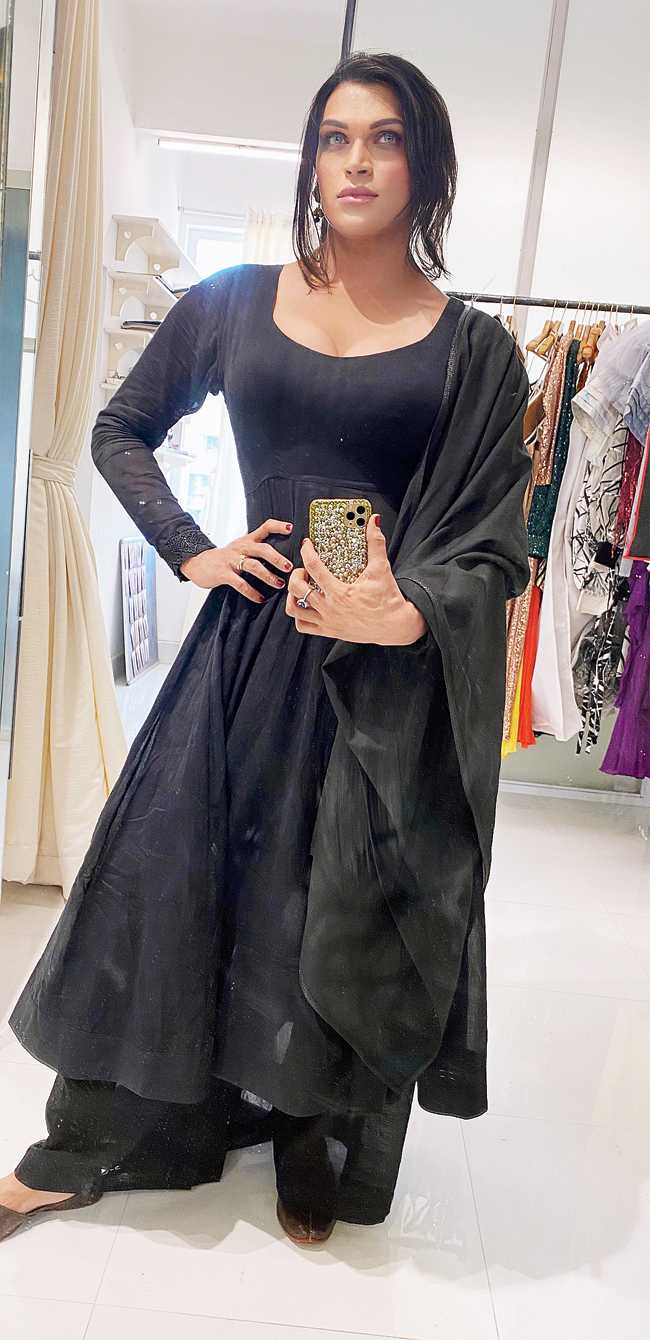
Saisha in the first outfit made by her team for her after her transition
Could you take us briefly through your phase of transitioning?
There was so much myth and misinformation around that clouded my mind regarding therapy. Some even went as far to tell me that I could be suicidal. So, I had all these preconceived notions. But the moment I started my hormone replacement even after a year-and-a-half now, I have not experienced any of that. Everything when done under the supervision of doctors is all good. Firstly, my major concern was the HRT, which went smoothly and is going smoothly. Secondly, the social stigma. The acceptance and comfort level of people around me. I am the boss, I have a team that has seen me as a man for all these years, for them to call me ma’am and getting used to it — all these things were also on my mind but I feel extremely blessed in life. From the security in my office, or the help to my team and people of the industry, everyone has been absolutely amazing. I would like to talk about the surgery after it is complete. I just had the breast implant surgery and that has been the most fulfilling surgery so far, I automatically feel a lot more feminine now.
Are people making efforts to know the gender non-conforming and is there awareness? What has your experience been like since the transition?
That is such a tricky question because considering the fact that I am an established designer and I am a known face there is an automatic sense of respect that comes from people, everyone is good to me. That is one of the reasons I feel privileged enough to talk about this. Do people make mistakes? Yes, in terms of my pronouns. Do I correct them politely? Yes. Do they accept it nicely? Yes. Do they follow it? Yes. Eventually it is about talking with respect. I think we really underestimate Indians, especially the ones who are not so educated. Talk to them with respect and they give it back to you. That’s been my experience.
Have you encountered any incident related to violence or phobia with your identity? How did you cope with it?
By God’s grace I haven’t. And the kind of person I am, I am extremely well-informed. So, for instance if I know that there will be a position where I might have some problem, I make sure it is sorted well in advance.
But yes, school life is miserable for anyone who doesn’t fit the image of normal as considered by the society. So, if you are fat, dark or effeminate you have a miserable school life. I was one of those kids who was fat and effeminate. Not very effeminate but had some features. So, I was an easy target as far as teasing or abusing is concerned. I would wait for school hours to be over. People couldn’t talk about these to teachers in those days because people were absolutely clueless.
And there is something I have understood from the people of the LGBTQ+ community. We start learning at a very young age how to defend ourselves, which is why in future we become so fearless and brave that everything we face after school and college feel trivial because we face that at such a young age.
Did you open up to your family then?
My parents are from a different generation altogether, where you don’t really communicate. When I became an adult, I understood the beauty of communication and I made that change in my family. But as a kid, I had no outlet or vent and the only vent I had was creative.
What was your process of becoming aware of your identity?
You don’t come to know about your identity one fine day but you come to know the term. When I learned the term and that I was a girl trapped in a boy’s body, the only visual or information I had was the hijras and the joke of their representation on television and films. When I saw that, I told myself that for sure is not me. So, maybe I am just gay. But when the realisation came that I am actually a trans person, thanks to the Internet, I started taking therapy for it. And during those intensive sessions of therapy the acceptance of my transness came in and when I accepted, the next step was to do something about it. So, I have been pretty methodical about it.
Is your career in fashion and your identity related at any point in this journey?
Not really. But one of the ways I vented out my frustration in school was through art and ended up choosing fashion as a career because of my love for art. I was absolutely amazing at drawing, sketching and painting and I remember seeing a fashion show by Gianni Versace in my school days. That was the point I knew I wanted to get into fashion and be a designer. That my profession and my industry helped me in being confident to achieve what I wanted to achieve in terms of my identity is true but in the choice of my career it had no role to play, that would be absurd!
For years you have dressed women and so many Bollywood divas too. How did you feel to dress yourself up as a woman for the first time?
(Laughs) I am still learning. I have a broad frame... for me to change all of that and change my body type as per the way I see myself as a woman... I could be very happy as a transwoman in the body I have but there is a certain vision I have for my body and once I reach there, probably what I like to wear would become easier. As far as my brand is concerned, it has completely changed. My core aesthetic and the fact that my brand identity is provocative is still there. But it has become a lot more conscious in terms of wearability now. First it was a gay man trying to make clothes for women. I didn’t really think about where the woman is going to wear the clothes. I just created. Whereas now I create with a thought where is this woman wearing this or where am I going to wear it or is it just an expression of my art. All these questions have become very important now.
What was the first attire you chose to dress up in?
When I accepted my sexuality, I used to cross dress at home but those I don’t think I am going to count. But my team made an outfit for me and they were really excited to make it. It was the first time that I was going to be on the red carpet of an event. It might not be the best outfit ever but it is definitely one of the most special outfits. I remember I was extremely nervous because I was going to be in front of the media for the first time in my outfit and I am never gonna forget that experience.
How do you think the world of fashion can play a role in the acceptance of the gender non-conforming in the society?
I think, firstly, they need to include collections for everyone instead of making a collection for publicity campaigns and then when you go to shop there is nothing. The staff should not be disrespectful. But most important is to have a collection that any person can buy irrespective of how they choose to identify. I think that is the day one can proudly say that inclusivity actually happened. Once a year publicity during Pride Month is very hollow.
Pictures: Saisha Shinde

